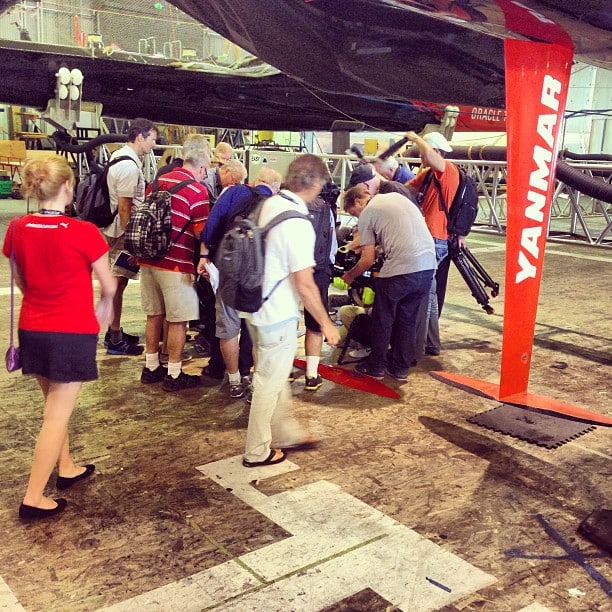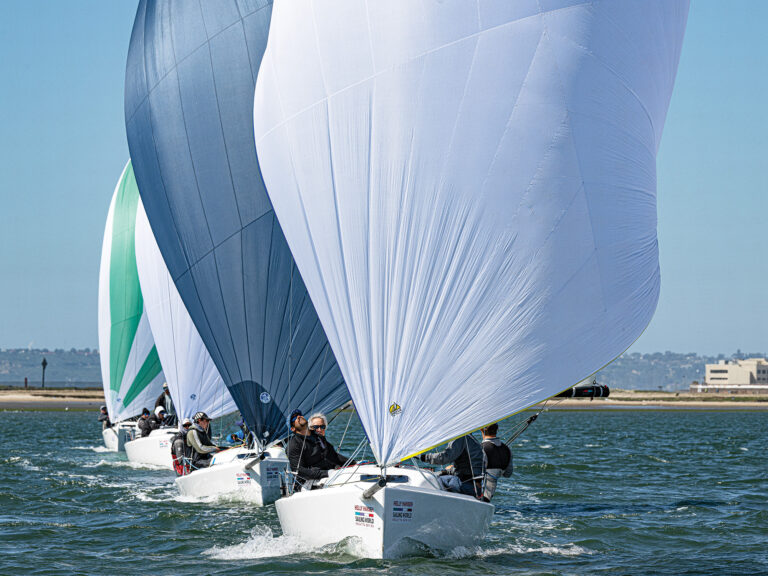
Ruddergate
As downtown San Francisco bustled and the waterfront Embarcadero hummed with tourists on Wednesday afternoon, 24 hours before the official opening ceremonies of the 34th America’s Cup Summer of Sailing, all was relatively quiet in the America’s Cup Park. Scant curious types wandered the vacant concert venue while work crews continued to assemble hospitality structures. In the lee of Pier 27 where all the onshore action will take place over the next three months, the three AC45s of Artemis, Oracle, and Red Bull bobbed on their moorings, providing the only hint of an impending regatta. Inside the media center, rows of tables sat unoccupied. With the exception of regatta director Iain Murray’s hour-long press conference earlier in the day (I’ll get to “ruddergate” shortly), there was nothing to report. It was the calm before the storm.
In the afternoon, a handful of reporters, myself included, were whisked away by either boat or car (pulled from the fleet of official Lexus sedans) to Oracle Team USA’s compound at Pier 80 for a base tour, some 5 miles around the corner from all the action. What should have been a 10-minute drive turned out to be 45-minute exercise in gridlocked traffic brought on by a union strike by Bay Area Rapid Transit employees.
After signing a confidentiality waiver—no photos, no secrets—I was escorted into the team’s expansive converted warehouse. To my left was the team’s gym, and to my right, one of its AC72s wings, resting on its cradles. The tour had already begun and a scrum of reporters huddled around one of Oracle’s engineers, peppering him with questions. Team CEO Russell Coutts stealthfully emerged from the team’s lounge and waited behind group. Calm and focused, as he usually is, he immediately engaged the group when they realized his presence.
And in an instant he was leading the reporters to the far end of the warehouse, stuck to him like paparazzi to Madonna, camera lights ablaze, digital recorders thrust forward, recording his every word. It was a comical scene, enough so that teammember Shannon Falcone stopped whatever it was he was doing to snap a picture of the frenzy with his camera phone (#racingsf).
Coutts, who has been all but silent since Artemis’ capsize, led us to one of the two AC72s (the other was just returning from sailing). He was ready to feed the media’s obsession over the boat’s narrow sharp orange rudders hanging on his boat, and more specifically the horizontal wings at their bottoms.
And what was all the to-do about the rudders? There are ample stories on the web, and Iain Murray’s press conference of the morning laboriously explained the rule brouhaha, but it can be essentially boiled down as follows—and yes, it’s complicated.
When Artemis Racing capsized, death resulting in crewmember Andrew Simpson, regatta organizers—led by Murray, convened an independent panel to investigate how to make the AC72s safer for competition. On May 22 Murray delivered his 37-point plan. At the time, he says, he had full support (“in principle”) from all four stakeholders. For the regatta to proceed on July 7, Murray needed to assure the U.S. Coast Guard that all teams accepted the 37 recommendations in whole. No USCG blessing, no event permit, no regatta.
All was proceeding quietly in June until Murray finally applied for his event permit, which was accepted by the USCG on the condition that all 37 recommendations were in place. Those recommendations, however, included fundamental design changes to the AC72 class rules, specifically the rudders. Deeper rudders and larger horizontal wings would be allowed. These wings, so called “elevators,” help control the flight of the boat when it’s foiling, preventing the bow-burying (pitch-pole) tendencies of the multihull. In theory, the bigger the elevator (in area) the better control, and the better the control, the safer the boat.
Emirates Team New Zealand called bull on the change, and subsequently so too have the Italian’s of Luna Rossa, accusing Murray of being in bed with Oracle and unjustifiably changing the rules in the 11th hour before racing. ETNZ contends that Oracle is behind the rule change because their boat did not foil well with their smaller elevators.
“Get them to explain to why the bigger wing isn’t safer than the smaller one,” said Coutts. “In a pitchpole situation, the downward force goes up in direct proportion to the area. It’s friggin’ obvious. So get them to explain what they don’t understand about that not being safer.”
The Italians and the New Zealanders claim that Murray overstepped his powers by chaning the class rules, and both have outstanding protests to be heard by an International Jury. If the jury finds against Murray, he said he would have no choice but to report to the Coast Guard that safety requirements would not be met, thereby voiding the permit and jeopardizing the regatta.
That, of course, doesn’t sit well with the Defender.
“This racing in July doesn’t mean anything,” said Coutts. “Nobody’s going to get eliminated anyway. So if this makes the boats safer, then I say, comply with the rules whatever they are, get on with it, and let’s go racing. It’s not going to hinder [ETNZ’s development]. You can build these rudder wings out of carbon; the attachment fitting takes a while to machine, but presumably they can machine that reasonably quickly. We can build those in a machine shop in three days so it’s not the end of the world.”
As it stands before the first race on Sunday, both Luna Rossa and ETNZ are compliant using their minimally sized rudder elevators. Given the number of supporters for both teams who have traveled to see the first race, it’s likely (and hopeful) we’ll see the first action on Sunday afternoon. Louis Vuitton’s portion of the regatta has been reduced to a mere spectacle of sailing and training days for the New Zealanders and Italians, as Artemis silently goes about the business of building its boat with depleted team. And as far as Coutts is concerned, the show will go on. When asked if the event could possibly be cancelled, he paused for a few seconds before saying, “I don’t know. I’m not thinking about it right now. I’m thinking about how to get our team faster. If Luna Rossa wants to pack up their toys and not race, I don’t give a shit. I really don’t. Couldn’t give a damn. I couldn’t.
“Through their behavior of the past two years they’ve clearly shown through their actions that they don’t care about this event and they don’t support it. I’m over it. I’m not going to worry about them. I’m going to worry about my team racing on September 7. If they refuse to go out, what can I do? I can’t change that.”









